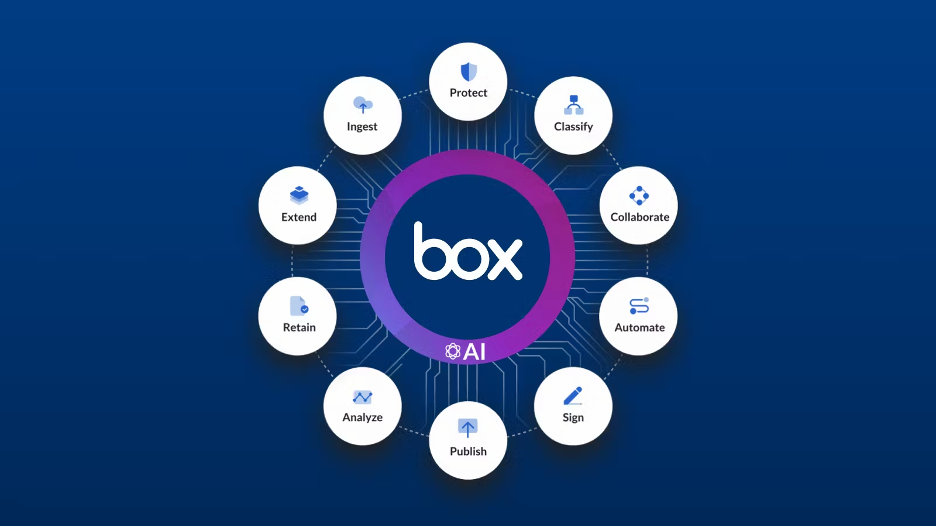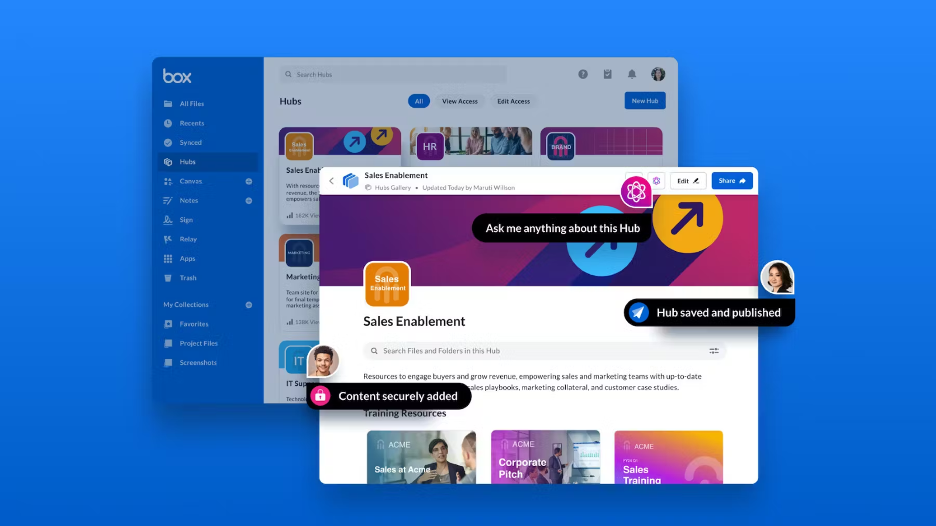
Enterprises have managed content using a file-in-folder approach for decades. Sharing and managing content like this is typically adequate for individuals or small groups. But it creates challenges in larger teams when there is a lot of data to manage. The rise in remote work has made the need for efficient and safe content sharing even more pronounced.
To address this challenge, cloud content management company Box has introduced Box Hubs, a solution that allows users to create centralized microsites for specialized content sharing. This tool enables users to custom-curate and publish content from their Box accounts for access by other Box users.
The Box Hubs platform, which will launch in early 2024, will tightly integrate with Box AI, a collection of generative AI tools. The goal of Box AI is to enhance productivity for creators and consumers of enterprise content, making organizational files more useful. Box Hubs moves that goal up a notch by tailoring and narrowing search parameters within the enterprise so that Box AI can query contextual information rather than massive data repositories. For example, if someone needs to know a company’s vacation policy, Box AI targeted at an HR-specific Box Hub is more likely to find relevant information—and far less likely to “hallucinate”—than if it needed to search all the company’s files.

How Box Hubs Works
Unlike traditional search methods where users actively seek information, Box Hubs provides a proactive solution to distribute targeted content to relevant audiences. Owners of Hubs organize files in a centralized gallery, each of which should offer an efficient location to find specific material without having to perform tedious searches or navigate through numerous folders. Users can also still choose existing search features within Box to find what they are looking for.
Box Hubs is a no-code solution, so users can create and customize Hubs without IT resources. In Hubs, users can organize content into a user-friendly format and publish it without relocating the original file from its current folder or manually copying it. Users can integrate new content from Box into a Box Hub as needed. When a user transfers content into a Hub, the document maintains established security and permissions so that only the intended audience can access it.
The Impact of Content Management on Productivity
Managing content so that workers can access the correct information at the right time is challenging, regardless of the size of an organization. Enterprise data is often siloed within different departments or different systems, making it hard to access and share information. Data quality issues, including incomplete and unstructured data and inconsistent naming strategies, make finding the right information time-consuming. IBM estimates that employees spend an average of three hours daily searching for information.
In that context, it makes sense to me to deploy a “copilot”—Box AI in this case—to help reduce the time workers spend finding information so they can spend time on more meaningful tasks. Microsoft has found success in doing just that. The company’s recent Work Trend Index shows that 75% of early users of Microsoft Copilot in 365 Chat say the tool saves them time finding what they need. Similarly, AI used within Box Hubs should efficiently identify and locate unstructured data such as documents, files and images housed in Box’s extensive content management system.
The Content Management Market
Microsoft’s OneDrive and SharePoint platforms offer similar capabilities to Box’s, as does Zoho WorkDrive. Adobe’s GenStudio addresses the same content management, publishing, and control challenges that Hubs does, but in a broader end-to-end solution for creative content, including steps from ideation to content performance.
SharePoint comes closest to being a direct competitor to Box Hubs, but SharePoint is not known to be user-friendly and requires hefty IT support. If Box Hubs can deliver on the promise of a user-friendly and IT-light experience, I think it would win out over SharePoint when the choice exists.
In some cases, it’s not a question of Box or Microsoft. Sometimes it’s and. Microsoft is a Box competitor, but the companies are also partners. Earlier this year, Box announced a plugin that lets joint customers use Microsoft 365 Copilot tools to summarize and query content in Box. Box also announced updates to its integrations in Microsoft 365 for Microsoft Teams and productivity tools such as Word, Excel, and PowerPoint.
For individual users and small businesses that need cloud file storage and sharing but may not require comprehensive content management systems, Dropbox recently introduced two new AI systems, Dropbox AI and Dropbox Dash. Dropbox AI summarizes content in file previews to help streamline understanding of large documents or videos without manual file exploration. This functionality will soon extend to folders and the entirety of Dropbox. Dropbox Dash, an AI-powered universal search feature, integrates various tools, content, and apps into a unified search bar to reduce toggle time. Dropbox Dash is compatible with major platforms including Google Workspace, Microsoft Outlook, and Salesforce and should provide more efficient access to multiple forms of content in one location.
My Analyst Take
Box Hubs is a good example of a content management tool that may efficiently organize, centralize, and distribute secure data. I think that Box has the potential to make the solution truly AI-centric by having Box AI suggest curated content within Hubs. Imagine a scenario where the AI picks up on a pattern within files to match items that seem to belong together. Rather than choosing from a wide range of content throughout an enterprise, the AI could prepopulate a Hub, leaving users with the simpler task of selecting or unselecting content. This is a natural evolution of the product, and I expect it will happen in short order.
Box Hubs was announced several months before its general availability, a timeline typical for many GAI tools. Competitors have already released similar features. Still, Box is known for its enterprise-level security encryption, which will likely deter many Box users from migrating to another solution.
In the bigger picture, GAI has tremendous potential in daily workflows for extracting knowledge from stored content that may lie dormant or underutilized. Over time, it should reduce search time based on the AI’s contextual understanding of location and file contents. Historically, robust content and data management systems were required to lay the groundwork for precise, integrated and secure data handling. That groundwork could also serve as a foundation for efficient and reliable content search. AI has the power to transform both processes.
If GAI tools can turn those three hours a day spent searching for information into time spent on meaningful work, that is more than just a minor productivity boost. That will be a significant change, and I look forward to seeing it happen.























































































